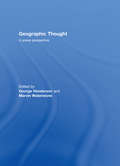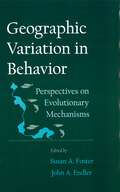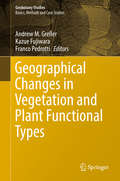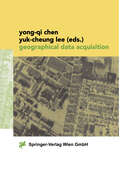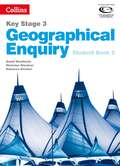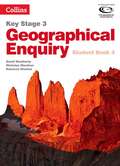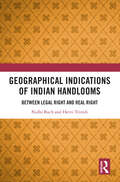- Table View
- List View
Geographic Thought: A Critical Introduction (Critical Introductions to Geography)
by Tim CresswellGeographic Thought An accessible and engaging introduction to geographic thought In the newly expanded Second Edition of Geographic Thought: A Critical Introduction, renowned scholar Tim Cresswell delivers a thoroughly up-to-date and accessible examination of the major thinkers and key theoretical developments in the field. Coverage of the complete range of the development of theoretical knowledge—from ancient geography to contemporary theory—appears alongside treatments of the influence of Darwin and Marx, the emergence of anarchist geographies, the impact of feminism, and myriad other central bodies of thought. This latest edition also includes new chapters on physical geography and theory, postcolonialism and decoloniality, and black geographies. The author emphasizes the importance of geographic thought and its relevance to our understanding of what it means to be human and to the people, places, and cultures of the world in which we live. This new edition contains: New examples throughout consisting of contemporary research from a wider range of geographical contexts and by geographers from diverse backgrounds Comprehensive explorations of physical geography that combine updated coverage from the first edition with brand new material Updated discussions of spatial science and quantitative methods that include considerations of the role of place and specificity in quantitative work In-depth examinations of the Anthropocene, the uses of assemblage theory, and the emergence of the GeoHumanities. Perfect for students of undergraduate and graduate courses in geographic thought, Geographic Thought: A Critical Introduction will also earn a place in the libraries of students and scholars researching the history and philosophy of geography, as well as practicing geographers.
Geographic Thought: A Critical Introduction (Critical Introductions to Geography)
by Tim CresswellGeographic Thought An accessible and engaging introduction to geographic thought In the newly expanded Second Edition of Geographic Thought: A Critical Introduction, renowned scholar Tim Cresswell delivers a thoroughly up-to-date and accessible examination of the major thinkers and key theoretical developments in the field. Coverage of the complete range of the development of theoretical knowledge—from ancient geography to contemporary theory—appears alongside treatments of the influence of Darwin and Marx, the emergence of anarchist geographies, the impact of feminism, and myriad other central bodies of thought. This latest edition also includes new chapters on physical geography and theory, postcolonialism and decoloniality, and black geographies. The author emphasizes the importance of geographic thought and its relevance to our understanding of what it means to be human and to the people, places, and cultures of the world in which we live. This new edition contains: New examples throughout consisting of contemporary research from a wider range of geographical contexts and by geographers from diverse backgrounds Comprehensive explorations of physical geography that combine updated coverage from the first edition with brand new material Updated discussions of spatial science and quantitative methods that include considerations of the role of place and specificity in quantitative work In-depth examinations of the Anthropocene, the uses of assemblage theory, and the emergence of the GeoHumanities. Perfect for students of undergraduate and graduate courses in geographic thought, Geographic Thought: A Critical Introduction will also earn a place in the libraries of students and scholars researching the history and philosophy of geography, as well as practicing geographers.
Geographic Thought: A Praxis Perspective
by George Henderson Marvin WaterstoneWithout social movements and wider struggles for progressive social change, the field of Geography would lack much of its contemporary relevance and vibrancy. Moreover, these struggles and the geographical scholarship that engages with them have changed the philosophical underpinnings of the discipline and have inflected the quest for geographical knowledge with a sense not only of urgency but also hope. This reader, intended for advanced undergraduate and beginning graduate courses in Geographic Thought, is at once an analysis of Geography’s theoretical and practical concerns and an encounter with grounded political struggles. This reader offers a fresh approach to learning about Geographic Thought by showing, through concrete examples and detailed editorial essays, how the discipline has been forever altered by the rise of progressive social struggles. Structured to aid student understanding, the anthology presents substantive main and part introductory essays and features more than two dozen unabridged published works by leading scholars that emphatically articulate geographic thought to progressive social change. Each section is introduced with an explanation of how the following pieces fit into the broader context of geographic work amidst the socially progressive struggles that have altered social relations in various parts of the world over the last half-century or so. Doubly, it places this work in the context of the larger goals of social struggles to frame or reframe rights, justice, and ethics. Geographic Thought provides readers with insights into the encounters between scholarship and practice and aims to prompt debates over how social and geographical knowledges arise from the context of social struggles and how these knowledges might be redirected at those contexts in constructive, evaluative ways. The reader is unique not only in knowing Geographic Thought through its progressive political attachments, instead of through a series of abstract "isms", but in gathering together salient works by geographers as well as scholars in cognate fields, such as Nancy Fraser, Chantal Mouffe, Iris Marion Young, and Jack Kloppenberg, whose own engagements have proved lasting and influential. For researchers and students interested in the connections between theoretically informed work and the possibilities for bettering people’s everyday lives, this book provides an innovative and compelling argument for why Geographic Thought is valuable and necessary.
Geographic Uncertainty in Environmental Security (NATO Science for Peace and Security Series C: Environmental Security)
by Ashley Morris Svitlana KokhanThis book features papers presented at a NATO Advanced Research Workshop, help in Kyiv, Ukraine, in July 2006. The workshop focused on how uncertainty and fuzziness can be better modeled and implemented in Geographic Information Science to help decision makers make more informed choices, especially as they pertain to environmental security and protection, and brought together top researchers from both NATO countries as well as partner countries.
Geographic Variation in Behavior: Perspectives on Evolutionary Mechanisms
by Susan A. Foster John A. EndlerStudies of animal behavior often assume that all members of a species exhibit the same behavior. Geographic Variation in Behavior shows that, on the contrary, there is substantional variation within species across a wide range of taxa. Including work from pioneers in the field, this volume provides a balanced overview of research on behavioral characteristics that vary geographically. The authors explore the mechanisms by which behavioral differences evolve and examine related methodological issues. Taken together, the work collected here demonstrates that genetically based geographic variation may be far more widespread than previously suspected. The book also shows how variation in behavior can illuminate both behavioral evolution and general evolutionary patterns. Unique among books on behavior in its emphasis on geographic variation, this volume is a valuable new resource for students and researchers in animal behavior and evolutionary biology.
Geographic Visualization: Concepts, Tools and Applications
by Martin Dodge Mary McDerby Martin TurnerGeographic Visualization: Concepts, Tools and Applications is a ‘state-of-the-art’ review of the latest developments in the subject. It examines how new concepts, methods and tools can be creatively applied to solve problems relevant to a wide range of topics. The text covers the impact of three-dimensional displays on user interaction along with the potentialities in animation and clearly explains how to create temporally sensitive visualizations. It also explores the potential for handling mobile data and representing uncertainty; as well as the role of participatory visualization systems and exploratory methods. Hallmark Features: An introduction to the diverse forms of geographic visualization which draws upon a number of theoretical perspectives and disciplines to provide an insightful commentary on new methods, techniques and tools. Richly illustrated in full colour throughout, including numerous relevant case studies and accessible discussions of important visualization concepts to enable clearer understanding for non-technical audiences. Chapters are written by leading scholars and researchers in a range of cognate fields, including, cartography, GIScience, architecture, art, urban planning and computer graphics with case studies drawn from Europe, North America and Australia This book is an invaluable resource for all graduate students, researchers and professionals working in the geographic information sector, computer graphics and cartography.
Geographic Visualization: Concepts, Tools and Applications
by Martin Dodge Mary McDerby Martin TurnerGeographic Visualization: Concepts, Tools and Applications is a ‘state-of-the-art’ review of the latest developments in the subject. It examines how new concepts, methods and tools can be creatively applied to solve problems relevant to a wide range of topics. The text covers the impact of three-dimensional displays on user interaction along with the potentialities in animation and clearly explains how to create temporally sensitive visualizations. It also explores the potential for handling mobile data and representing uncertainty; as well as the role of participatory visualization systems and exploratory methods. Hallmark Features: An introduction to the diverse forms of geographic visualization which draws upon a number of theoretical perspectives and disciplines to provide an insightful commentary on new methods, techniques and tools. Richly illustrated in full colour throughout, including numerous relevant case studies and accessible discussions of important visualization concepts to enable clearer understanding for non-technical audiences. Chapters are written by leading scholars and researchers in a range of cognate fields, including, cartography, GIScience, architecture, art, urban planning and computer graphics with case studies drawn from Europe, North America and Australia This book is an invaluable resource for all graduate students, researchers and professionals working in the geographic information sector, computer graphics and cartography.
A Geographical Century: Essays for the Centenary of the International Geographical Union
by Vladimir Kolosov Jacobo García-Álvarez Michael Heffernan Bruno SchelhaasThis volume of specially commissioned interpretative essays marks the centenary of the establishment of the International Geographical Union in 1922. Written by leading human and physical geographers from all parts of the world, A Geographical Century considers the history and present condition of geography as an international science. Based on the latest research, A Geographical Century provides new and critical analyses of the different forms of geographical internationalism that emerged during the 20th century; the changing relations between geography and cognate disciplines in the natural and social sciences; the geopolitics of international geographical collaboration; and the prospects of geography as a 21st century international science.
Geographical Changes in Vegetation and Plant Functional Types (Geobotany Studies)
by Andrew M. Greller Kazue Fujiwara Franco PedrottiThis book presents studies on current vegetation topics, from polar to tropical regions. It is a festschrift to mark the 70th birthday of Prof. Elgene O. Box, who has studied vegetation all over the world, both through fieldwork and modeling. It reflects a number of his interests, including basic ecological plant forms (cf ‘plant functional types’), temperate-zone forests, and evergreen versus seasonal patterns. Section 1 discusses the concept of vegetation series, while Section 2 has two global-scale chapters on plant functional traits and whether they are related more to climate or phylogeny. Section 3 has nine chapters focusing on vegetation history, regional vegetation, and how these have influenced current species organizations and distributions. Regions treated include Russia, China, the USA, Mexico and Mediterranean areas. Lastly, Section 4 addresses aspects of vegetation change and plant ecology. Every chapter in this unique book offers original ideas on the topic of vegetation, as the authors are assembled from a world-wide population of leading vegetational ecologists, whose interests range from local communities to global theoretical questions.
Geographical Data Acquisition
by Yuk-CheungLee Yong-QiChenThis book presents the theory and methodology of geographical data acquisition, providing comprehensive coverage ranging from the definition of geo-referencing systems and transformation between these systems to the acquisition of geographical data using different methods. The material provides readers with a good understanding of the nature of spatial data, the accuracy of spatial data, and the theory behind various data acquisition methodologies.
Geographical Dimensions of Energy (GeoJournal Library #5)
by Barry D. Solomon Frank J. CalzonettiThis book is the first attempt to provide a comprehensive volume on the topic of energy geography. The book reviews research on energy geography, contain~ original refereed articles on energy and provides a chapter on future research directions in this subfield of geography. The book provides an overview of the research activity underway, and highlights the role of geographers and regional scientists in the study of energy topics. A diverse group of scholars contribute to the manuscript and the chapters show how di fferent research methodologies and approaches are employed in investigating a range of relevant energy problems. This book is intended for upper-level undergraduate students and graduate students in geography, regional science and related disciplines. It will also be useful to professional geographers who would like to know more about the energy geography subfield. Furthermore, the chapters will be interesting to applied geographers and energy policymakers who can see the value of the spatial perspective in addressing energy problems.
Geographical Dynamics and Firm Spatial Strategy in China (Springer Geography)
by Shengjun Zhu John Pickles Canfei HeThis book offers the first detailed account of the complex geographical dynamics currently restructuring China’s export-oriented industries. The topics covered are relevant to post-socialist geography, development studies, economics, economic sociology and international studies. It offers academics, international researchers, postgraduate and advanced undergraduate students in these fields an accessible, grounded, yet theoretically sophisticated account of the geographies of global production networks, value chains, and regional development in developing countries and emerging economies. It is of particular interest to economic geographers and economic sociologists involved in the growing debates over local clusters, embeddedness, global sourcing and global production, and over the global value chain/global production network. It also appeals to national policymakers, since it directly addresses economic and industrial policy issues, such as industrial competitiveness, regional and national development, industrial and employment restructuring and trade regulation.
Geographical Education in a Changing World: Past Experience, Current Trends and Future Challenges (GeoJournal Library #85)
by John Lidstone Michael WilliamsThis book results from the work of the Commission on Geographical Education of the International Geographical Union. Part 1 focuses on the distinctive traditions of school geography. Part 2 reviews the state of school geography on a broad continental basis, including national case studies by local experts. The final chapters extrapolate from the present and point to likely future developments in the subject, again with examples drawn from various countries.
Geographical Enquiry Student Book 2 (PDF)
by David Weatherly Nicholas Sheehan and Rebecca KitchenA variety of tasks allow you to: • Engage students with exciting visual content, real-world emphasis, fresh case studies and country profiles with regular online updates from the Geography Association. • Monitor student growth with ‘Check Your Progress’ exercises and prepare your class for KS4 with ‘Bridge to GCSE’ activities written by examiners. Pupil book enquiries are ‘How’ and ‘Why’ questions consisting of one overarching investigative question and a series of sub questions. Enquiries are supported by teacher resources that provide a clear steer in terms of approaches to learning and teaching and the generation of meaningful outcomes. These outcomes will be easily cross referenced to any national assessment requirements.
Geographical Enquiry Student Book 3 (PDF)
by David Weatherly Nicholas Sheehan and Rebecca KitchenFocusing on skills development – geographical, PLTS and functional – this book takes a lively and innovative approach to KS3 Geography.Building further on the skills, knowledge and subject understanding of Pupil Books 1 and 2, Pupil Book 3 contains rich tasks and activities which will thoroughly prepare pupils for GCSE Geography. Pupil book enquiries are ‘How’ and ‘Why’ questions consisting of one overarching investigative question and a series of sub questions. Enquiries are supported by teacher resources that provide a clear steer in terms of approaches to learning and teaching and the generation of meaningful outcomes. These outcomes will be easily cross referenced to any national assessment requirements.
Geographical Gerontology: Perspectives, Concepts, Approaches (Routledge Studies in Human Geography)
by Mark W. Skinner Gavin J. Andrews Malcolm P. CutchinUnderstanding where ageing occurs, how it is experienced by different people in different places, and in what ways it is transforming our communities, economies and societies at all levels has become crucial for the development of informed research, policy and programmes. This book focuses on the interdisciplinary field of study – geographical gerontology – that addresses these issues. With contributions from more than 30 leading geographers and gerontologists, the book examines the scope and depth of geographical perspectives, concepts and approaches applied to the study of ageing, old age and older populations. The book features 25 chapters organized into five parts that cover the field’s theoretical traditions and intellectual evolution; the contributions of key disciplinary perspectives from population geography, social and cultural geography, health geography, urban planning and environmental studies; the scales of inquiry within geographical gerontology from the global to the embodied; the thematic breadth of contemporary issues of interest that define the field (places, spaces and landscapes of ageing); and a discussion about challenges, opportunities and agendas for future developments in geography and gerontology. This book provides the first comprehensive foundation of knowledge about the state of the art of geographical gerontology that will be of interest to scholars of ageing around the world.
Geographical Gerontology: Perspectives, Concepts, Approaches (Routledge Studies in Human Geography)
by Mark W. Skinner Gavin J. Andrews Malcolm P. CutchinUnderstanding where ageing occurs, how it is experienced by different people in different places, and in what ways it is transforming our communities, economies and societies at all levels has become crucial for the development of informed research, policy and programmes. This book focuses on the interdisciplinary field of study – geographical gerontology – that addresses these issues. With contributions from more than 30 leading geographers and gerontologists, the book examines the scope and depth of geographical perspectives, concepts and approaches applied to the study of ageing, old age and older populations. The book features 25 chapters organized into five parts that cover the field’s theoretical traditions and intellectual evolution; the contributions of key disciplinary perspectives from population geography, social and cultural geography, health geography, urban planning and environmental studies; the scales of inquiry within geographical gerontology from the global to the embodied; the thematic breadth of contemporary issues of interest that define the field (places, spaces and landscapes of ageing); and a discussion about challenges, opportunities and agendas for future developments in geography and gerontology. This book provides the first comprehensive foundation of knowledge about the state of the art of geographical gerontology that will be of interest to scholars of ageing around the world.
A Geographical Guide to the Real and the Good
by Robert SackFirst published in 2003. Routledge is an imprint of Taylor & Francis, an informa company.
A Geographical Guide to the Real and the Good
by Robert SackFirst published in 2003. Routledge is an imprint of Taylor & Francis, an informa company.
Geographical Impact on Coastal Defense Navies: The Entwining of Force Structure, Technology and Operational Environment
by Michael S. LindbergCoastal defence navies constitute a distinct type of naval force in the world today. They possess a unique set of force structure and support infrastructure characteristics. And, more than any other type of navy, they are directly influenced by the geographical conditions of their operational environments. This book examines and classifies both coastal defence navies and their operational environments. Special attention is paid to the influence that geography has upon the force structure as well as the strategy and tactics of these navies.
Geographical Indication and Global Agri-Food: Development and Democratization (Earthscan Food and Agriculture)
by Alessandro Bonanno Kae Sekine Hart N. FeuerThis book addresses the relevance of geographical indication (GI) as a tool for local and socio-economic development and democratization of agri-food, with case studies from Asia, Europe and the Americas. A geographical indication is a sign used on products that have a specific geographical origin and possess qualities or a reputation that are due to that origin. It provides not only a way for businesses to leverage the value of their geographically unique products, but also to inform and attract consumers. A highly contested topic, GI is praised as a tool for the revitalization of agricultural communities, while also criticized for being an instrument exploited by global corporate forces to promote their interests. There are concerns that the promotion of GI may hamper the establishment of democratic forms of development. The contributing authors address this topic by offering theoretically informed investigations of GI from around the world. The book includes case studies ranging from green tea in Japan, olive oil in Turkey and dried fish in Norway, to French wine and Mexican Mezcal. It also places GI in the broader context of the evolution and trends of agri-food under neoliberal globalization. The book will be of interest to researchers, policy makers and students in agri-food studies, sociology of food and agriculture, geography, agricultural and rural economics, environmental and intellectual property law, and social development.
Geographical Indication and Global Agri-Food: Development and Democratization (Earthscan Food and Agriculture)
by Alessandro Bonanno Kae Sekine Hart N. FeuerThis book addresses the relevance of geographical indication (GI) as a tool for local and socio-economic development and democratization of agri-food, with case studies from Asia, Europe and the Americas. A geographical indication is a sign used on products that have a specific geographical origin and possess qualities or a reputation that are due to that origin. It provides not only a way for businesses to leverage the value of their geographically unique products, but also to inform and attract consumers. A highly contested topic, GI is praised as a tool for the revitalization of agricultural communities, while also criticized for being an instrument exploited by global corporate forces to promote their interests. There are concerns that the promotion of GI may hamper the establishment of democratic forms of development. The contributing authors address this topic by offering theoretically informed investigations of GI from around the world. The book includes case studies ranging from green tea in Japan, olive oil in Turkey and dried fish in Norway, to French wine and Mexican Mezcal. It also places GI in the broader context of the evolution and trends of agri-food under neoliberal globalization. The book will be of interest to researchers, policy makers and students in agri-food studies, sociology of food and agriculture, geography, agricultural and rural economics, environmental and intellectual property law, and social development.
Geographical Indications of Indian Handlooms: Between Legal Right and Real Right
by Nidhi Buch Hetvi TrivediThis book presents a comprehensive analysis of Geographical Indications (GI) in the Indian context with particular reference to the handloom sector. It discusses themes such as the rationale of GI as IP (intellectual property); the domestic position on GIs; GI protection under various international instruments; handlooms from Gujarat and their GI journey; the efficacy of GIs; and GI structure for handlooms. The volume fills the gap between law and policies and recommends the implementation of an efficient legal system. It highlights the status of Indian handlooms, a sector that represents the country’s cultural heritage and supports a range of livelihoods. We examine India’s GI protection system with its diverse cultures and explore how GI can help recognize, support and promote these products to bring socio-economic benefits. The work documents policy measures undertaken for the revival, restructuring and promotion of Indian handlooms and handicrafts, and will serve as an important intervention in Indian law on GI. An investigative study that evaluates the current law and policy on GI protection through detailed case studies and empirical research on select Indian handlooms, this book will be useful to scholars and researchers of geography, economics, development studies, sociology, law and public policy. It will also interest policymakers, legal practitioners, textile and handloom professionals, design and business administration institutes, media, arts and crafts museums and civil society organizations working on handlooms or in intellectual property.
Geographical Indications of Indian Handlooms: Between Legal Right and Real Right
by Nidhi Buch Hetvi TrivediThis book presents a comprehensive analysis of Geographical Indications (GI) in the Indian context with particular reference to the handloom sector. It discusses themes such as the rationale of GI as IP (intellectual property); the domestic position on GIs; GI protection under various international instruments; handlooms from Gujarat and their GI journey; the efficacy of GIs; and GI structure for handlooms. The volume fills the gap between law and policies and recommends the implementation of an efficient legal system. It highlights the status of Indian handlooms, a sector that represents the country’s cultural heritage and supports a range of livelihoods. We examine India’s GI protection system with its diverse cultures and explore how GI can help recognize, support and promote these products to bring socio-economic benefits. The work documents policy measures undertaken for the revival, restructuring and promotion of Indian handlooms and handicrafts, and will serve as an important intervention in Indian law on GI. An investigative study that evaluates the current law and policy on GI protection through detailed case studies and empirical research on select Indian handlooms, this book will be useful to scholars and researchers of geography, economics, development studies, sociology, law and public policy. It will also interest policymakers, legal practitioners, textile and handloom professionals, design and business administration institutes, media, arts and crafts museums and civil society organizations working on handlooms or in intellectual property.
Geographical Information and Climatology (Iste Ser.)
by Pierre CarregaThis book includes two parts. The first part is more theoretical and general, and it covers fundamental principles: geospatial climate data measurement; spatial analysis, mapping and climate; geographical information, remote sensing and climatology; and geographical information for initialisation of forecasting and climate models. The second part describes geographical information used in various climate applications of importance today, related to risk: urban climate; air pollution; hydrological problems linked to climatology; forest fires.

